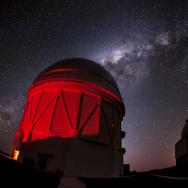When astronomers use telescopes to look back in time—toward objects in the universe whose light is only now reaching earth after billions of years—they see something odd. Black holes, big ones, that already existed when the universe was still very young.
This is strange because from what physicists have understood, it takes time for a black hole to eat enough surrounding matter to grow so massive—so it seemed those black holes should not have had time to get so big.
“The analogy I’ve used is that if you saw a child that was only five or six years old, but already weighed as much as an adult human,” said Hai-Bo Yu, an associate professor of physics and astronomy at University of California, Riverside.
Yu and two other scientists with UC Riverside and the University of Chicago came up with a surprising possible explanation: Those black holes could have formed with the help of dark matter.
“This ties together two great mysteries in astrophysics—early supermassive black holes and dark matter—very neatly,” said UChicago postdoctoral researcher and study co-author Yi-Ming Zhong.
In the early days of the universe, visible matter existed as clouds of gas particles that would grow into denser objects, such as stars and galaxies. These clouds could collapse and form a seed black hole, i.e., the baby stage of a supermassive black hole. However, in this scenario, the scientists said, the seed would not have enough time to grow into the most massive black holes observed in the early universe, if it eats at a “normal” pace.
But alongside the ordinary matter in these clouds was a halo of dark matter, a mysterious form of matter that we can tell is there because of its gravity pulls on visible things in the universe. The scientists wondered if dark matter could serve as an ingredient that helps create supermassive black holes.
According to their simulations, if particles of dark matter in those halos were colliding with each other, such activity could tip the balance of the system towards collapse. That’s because the particles could spread heat to one another as they collided, making the central halo unstable. They also found the dark matter collisions would dissipate the halo’s angular momentum—the quantity that describes the spinning of a body—which further tips the system towards collapse.
Such a collapse usually takes a long time. However, the presence of ordinary matter at the halo center adds extra mass that deepens the gravitational potential there, thus expediting the heat spread. “The presence of ordinary matter could shorten the collapse timescale by two orders of magnitude,” said graduate student and co-author Wei-Xiang Feng.
These “seed” black holes would have been much massive than those typically formed by the collapse of ordinary gas—akin to the baby in the analogy being born already weighing 100 pounds. From there, it could grow through the “normal” process of eating nearby matter.
The scientists are investigating further implications of this theory, such as the origin of supermassive black holes in our own Milky Way and many other large nearby galaxies. It could also be an indication about the nature of dark matter itself; it’s difficult to directly observe whether or not dark matter particles can collide among themselves, but if this theory pans out, it could serve as evidence that they can.
A way to test this theory might become possible as the next generation of more powerful telescopes begin taking data. For example, the Giant Magellan Telescope will be probing the growth of black holes in the universe.
“This system has very novel and interesting dynamics, so we’re exploring further,” said Zhong. “Plus, it’s intriguing that we can address two mysteries with one theory.”
Citation: “Seeding Supermassive Black Holes with Self-Interacting Dark Matter: A Unified Scenario with Baryons.” Feng, Yu, & Zhong, Astrophysical Journal Letters, June 16, 2021.
Funding: U.S. Department of Energy, NASA, Kavli Foundation, John Templeton Foundation.

